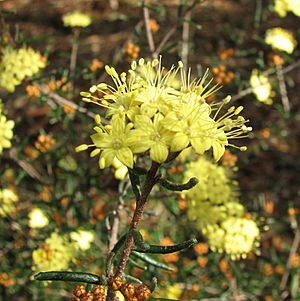Narrow-leaved phebalium facts for kids
Quick facts for kids Narrow-leaved phebalium |
|
|---|---|
 |
|
| Phebalium stenophyllum in Maranoa Gardens | |
| Scientific classification | |
| Genus: |
Phebalium
|
| Species: |
stenophyllum
|
| Synonyms | |
|
|

The Narrow-leaved phebalium (scientific name: Phebalium stenophyllum) is a type of small shrub. It grows only in south-eastern Australia, which means it is endemic to that area. This plant has branches covered in tiny scales. Its leaves are long and narrow, almost like a cylinder. When it blooms, you'll see pretty yellow flowers grouped together in clusters called umbels. Each cluster usually has three to ten flowers.
Contents
What Does It Look Like?
The Narrow-leaved phebalium is a shrub that usually grows about 1 to 1.5 meters (3 to 5 feet) tall. Its small branches have shiny, silvery or rust-colored scales.
Leaves
The leaves are narrow and oblong. Their edges are rolled under, making them look almost round like a cylinder. Each leaf is about 4 to 20 millimeters (0.16 to 0.79 inches) long and 0.8 to 3 millimeters (0.03 to 0.12 inches) wide. They grow on a short stem called a petiole. Older leaves have a smooth, hairless top surface. The bottom surface is covered with silvery scales, or sometimes you can't see it because of how the leaf is rolled.
Flowers
The flowers grow in groups of three to ten. These groups are called umbels and they sit directly on the stem without a stalk. Each individual flower has a small stem called a pedicel, which is about 3 to 8 millimeters (0.12 to 0.31 inches) long.
The calyx, which is the outer part of the flower that protects the petals, is shaped like half a ball. It's about 1 millimeter (0.04 inches) high and 2 millimeters (0.08 inches) wide. It's also covered in silvery or rust-colored scales. The petals are yellow and shaped like an oval. They are about 3.5 to 4.5 millimeters (0.14 to 0.18 inches) long and 2 millimeters (0.08 inches) wide. The back of the petals also has silvery and rust-colored scales. This plant usually flowers in the spring.
How It Got Its Name
This plant was first officially described in 1863 by a botanist named George Bentham. He called it Phebalium squamulosum var. stenophyllum. The first plant specimen used to describe it was collected by another famous botanist, Ferdinand von Mueller. He found it in the Grampians National Park and a desert area near the Murray River.
Later, in 1916, two other botanists, Joseph Maiden and Ernst Betche, decided it was unique enough to be its own species. So, they gave it the name Phebalium stenophyllum.
Where It Lives
The Narrow-leaved phebalium grows in different parts of south-eastern Australia. You can find it in areas with eucalypt trees, open heathlands, or mallee shrublands. It grows in separate groups, meaning it's not found everywhere in a continuous patch. These groups are in the central and southern tablelands of New South Wales. You can also find it near the border between Victoria and South Australia. It has been seen in places like Mt Zero and Mt Abrupt in the Grampians National Park, and near Blackwood.
Growing This Plant
People sometimes grow the Narrow-leaved phebalium in their gardens because it has beautiful flowers. This plant can handle some frost, which means it can survive cold temperatures. It grows best in soil that drains water well and in a spot that gets some shade. Once the plant is established, it can also handle dry periods without much water.
See also
 In Spanish: Phebalium stenophyllum para niños
In Spanish: Phebalium stenophyllum para niños

